The possibility of tolling on Portland highways isn’t sitting well with people who live north of the Columbia River
CLARK COUNTY — The future for commuting to Portland appears to be Value Pricing, a relatively new term that most people still refer to as tolling.
The state of Oregon has been exploring the idea of tolls on all or some of I-5 and I-205 from Tualatin north to the Columbia River, with a final plan expected by the end of the year.
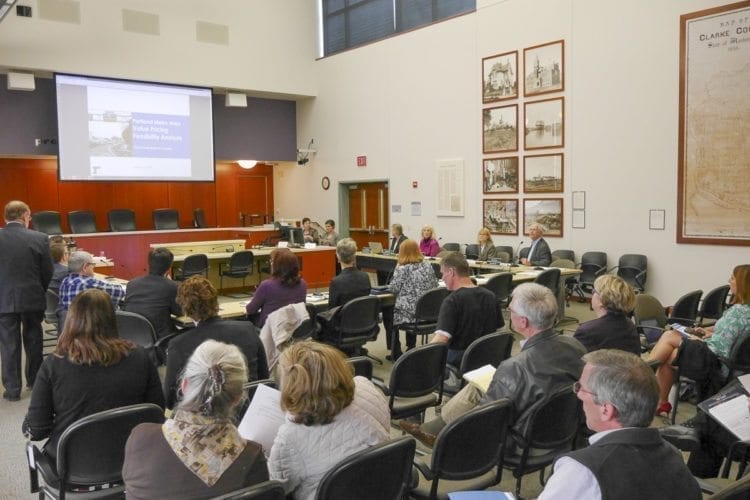
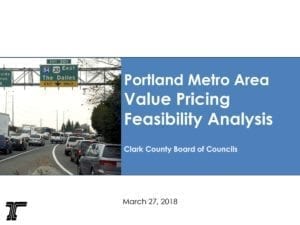
On Tuesday night, members of the Clark County Council hosted a work session, bringing together elected representatives from several cities in the county to hear from an Oregon Department of Transportation (ODOT) official and the consulting firm assisting with the project.
The presentation by ODOT’s Mandy Putney and WSP Consulting’s Kirsten Pennington was barely half over when the questions from the council members and mayors began.
“How do we mean ‘benefit?” asked Clark County councilor Jeanne Stewart. “We’re going to have Clark County citizens paying tolls, and getting no more capacity on the freeway.”
“It’s not a cure all,” replied Putney. “it’s one additional tool in the toolbox … We’ve heard from everyone that congestion really is a problem, and we need to try something different in addition to planning multi-modal projects and capacity projects, and bottleneck improvement projects.”
Councilor Eileen Quiring expressed her doubt about the efficacy of a toll relieving congestion to any appreciable degree, given the fact most people already avoid driving during peak commuting times. She also pointed out the unique challenge many Clark County commuters face.
“They have a large body of water to cross,” she said. “I don’t think people from Washington, during commuting hours, are using that freeway. They already know they can’t go anywhere. They’re sitting in their car and idling for long periods of time. So I think people have already chosen not to go during commuting hours.”
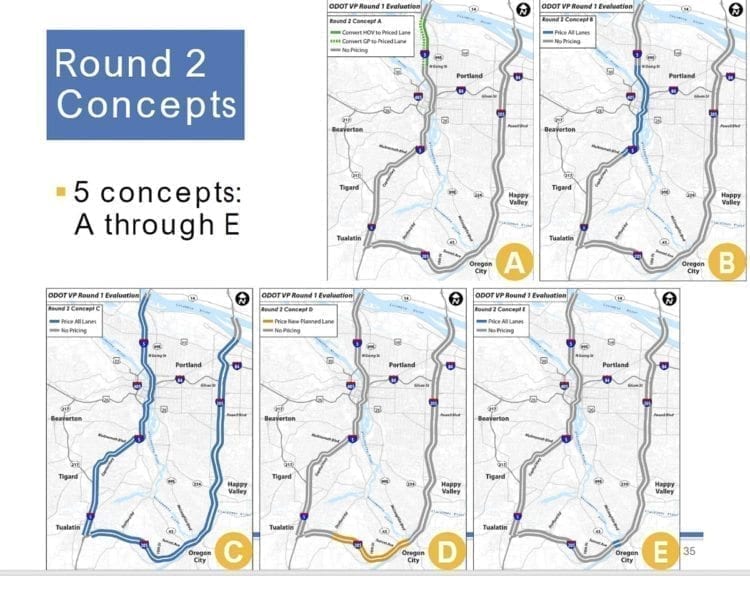
Quiring also voiced the concern of many in the room, over exactly how charging people to drive on a stretch of road would make things faster, especially given that Putney stated the intended goal is not, in fact, to take cars off the road.
“We’re trying to allow more people to get to where they want to go in a timely fashion,” Putney told the lawmakers. “That could be in a car, it could be a freight truck, it could be by transit or some other mode.”
The officials expressed their opinion that the current capacity is actually under-utilized, but that too many people trying to use the roads at the same time is causing most of the problem. If traffic were metered out over a longer stretch of time, their studies conclude, we would be able to more effectively use the current capacity.
The Value Pricing Policy Advisory Committee is the panel currently working to craft the final proposal on Value Pricing. It consists of 25 members, but only three are from Southwest Washington, including Clark County Councilor Jeanne Stewart, Vancouver mayor Anne Mcenerny-Ogle, and a representative from Washington State Department of Transportation. The other members are from Tri-Met, Metro, Fred Meyer, AAA Oregon, as well as ODOT and several other Oregon agencies.
A major point of contention during Tuesday’s work session centered around the impact of the potential tolls on residents of Clark County. Especially considering the rules dictate that none of the money potentially raised could be used for traffic improvements north of the river.
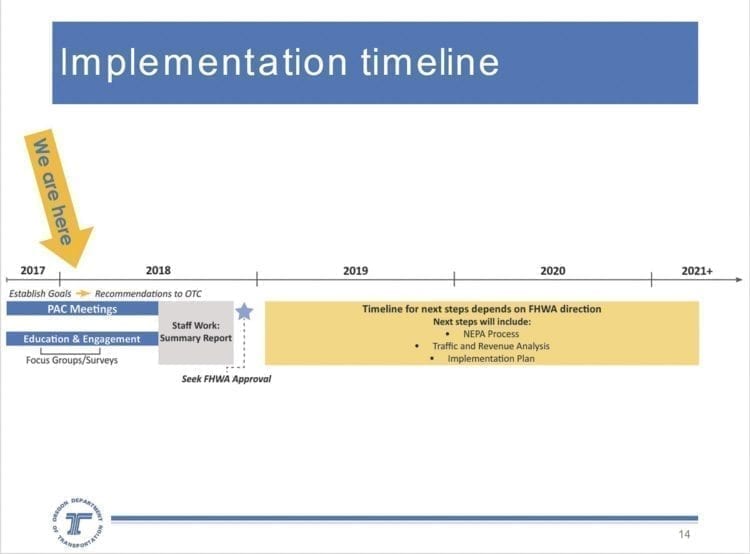
“We are shifting costs to Clark County residents,” Stewart complained. “That will really have no benefit whatsoever. So we can call it Value Pricing, which is so ridiculous it’s insulting. The ‘value’ is going to be on the Oregon side. There is no value to our citizens that are going to be paying these tolls.”
Stewart has maintained her preferred option would be a third Columbia River bridge between Vancouver and Portland, and increased spending on roadway capacity.
While questions were abundant, few answers were available. Putney and Pennington maintained that a lot isn’t known yet. For instance, exactly how much the tolls might be, whether there might be times when the roads are free, and whether any possible discount for certain people might even be available to commuters from Clark County, given that this is an Oregon program.
The question was also raised about why tolls weren’t being implemented on east-west highways in Portland, such as I-84 and Highway 26. The answer was that the direction from the legislature in Salem was to look at the most congested freeways first, meaning I-5 and I-205, but that tolls on other Portland area highways would likely be something considered in the future.
Carol Levanen, executive secretary of Clark County Citizens United, pointed out that a map in the presentation showing other places in the country that use Value Pricing on their roads didn’t indicate whether any of them involved an Interstate highway, or impacted people on the other side of a state line in the way this plan would.
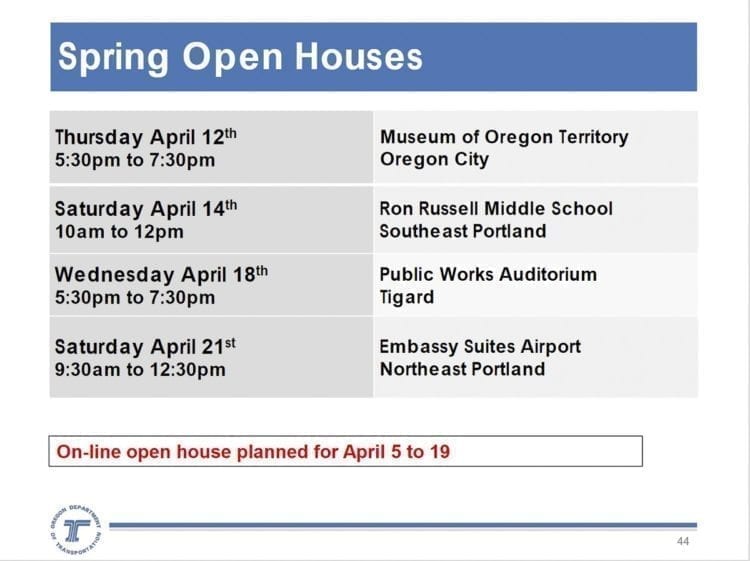
“It seems arrogant for the state of Oregon to think that they have total control of that I-5 corridor through their state,” Levanan said, “and it seems kind of arrogant of the Legislature of Oregon to think that they’re going to decide the life of all of the people beyond this state.”
Her suggestion, which echoed some of the elected leaders in the room, was that the state of Oregon might consider an income tax write off for people who live in Washington but work in the Portland area.
But it’s not just Clark County residents who might be impacted. One citizen who spoke up lives in Hayden Island, just south of the Interstate Bridge. His question was how a toll might affect people like him, who have few options aside from the freeway in order to get anywhere.
“I’m in a location where, I can’t go anywhere,” he said, “It’s a very unique location between I-5 and I-205 where it’s the only place that I can get on and off from my home.”
That was yet another question deflected with the line that there would be much more information in the coming months. Right now the Advisory Commission is hoping to have a final concept in place by mid-July. It would then go to the Federal Government for approval, a process that could take a year or longer. Full implementation of any tolling might not happen until 2020 or 2021, even if that approval is given.
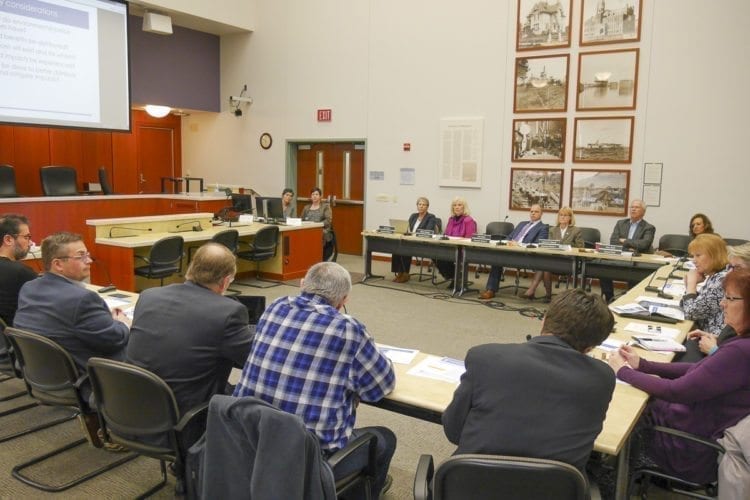
Seattle’s tolling of I-405 was mentioned as a success story by the presenters, but others pointed out that there have been issues. One is that, by one estimate, 40 percent of the proceeds go to the tolling company. After upkeep of the system, little money has been left over to spend on traffic improvements. There have also been concerns raised about who might have access to information about commuters using the system.
The presenters also mentioned that people who only use cash and don’t have access to banking can use the system, but it’s unclear at this point if they would face a hefty premium for that in Portland like they do in Seattle.
Are tolls a sure thing in Portland? Even that was a question the presenters struggled to answer, although the language from Salem seems to indicate that, short of a “no” from the Federal government, they’re paving the way for a pricier drive somewhere south of the river. It’s also clear that, whichever option ODOT eventually chooses, there will be plenty of unhappy people, and many or most of them will live in Clark County.




